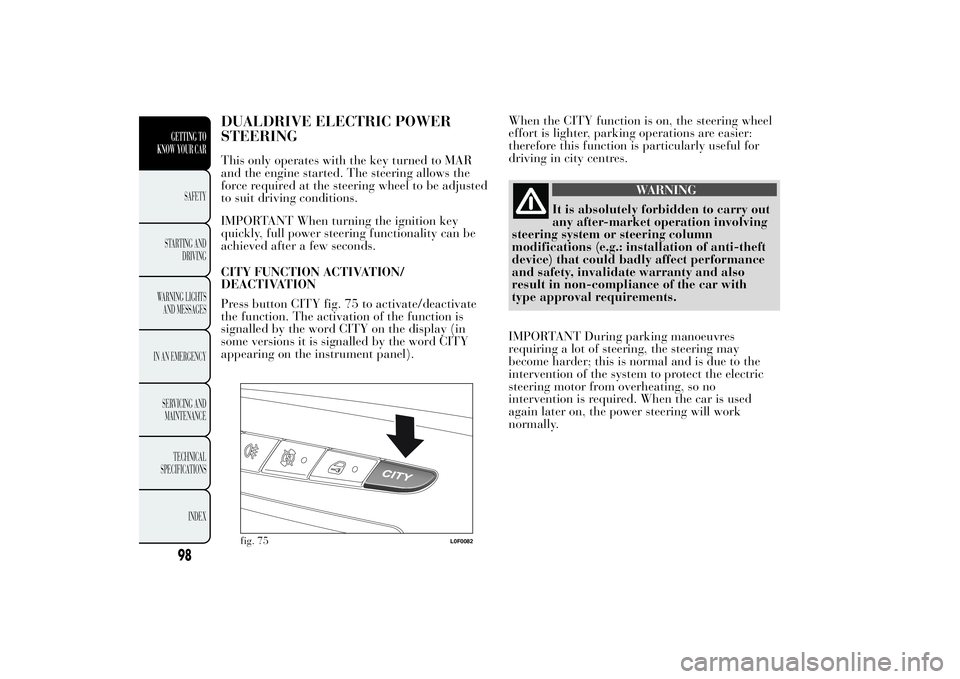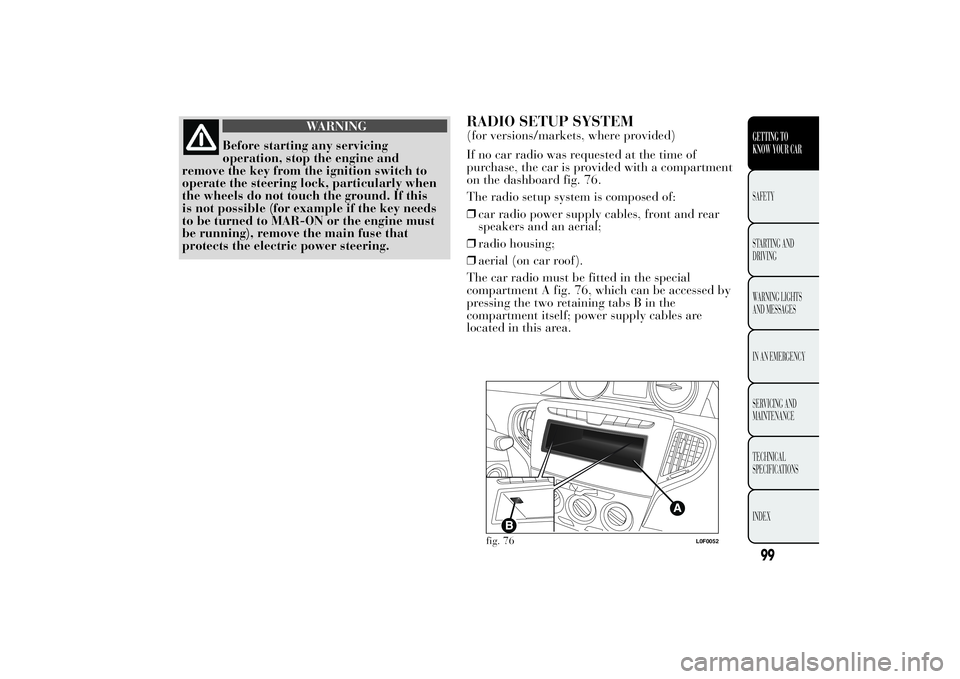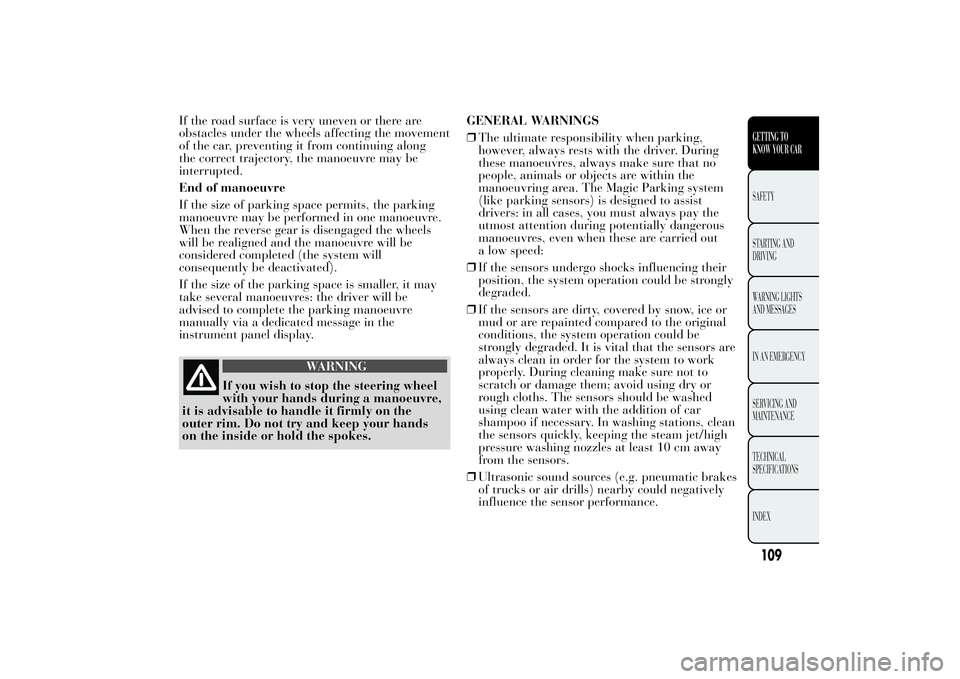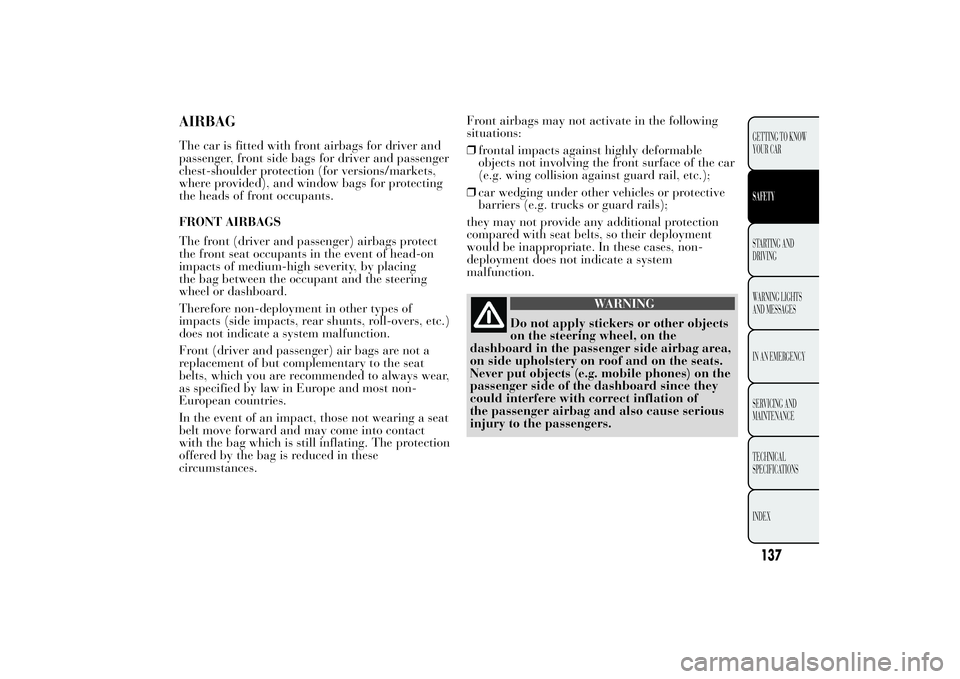steering Lancia Ypsilon 2012 Owner handbook (in English)
[x] Cancel search | Manufacturer: LANCIA, Model Year: 2012, Model line: Ypsilon, Model: Lancia Ypsilon 2012Pages: 307, PDF Size: 13.3 MB
Page 71 of 307

When the ECO function is activated, the car is set
for city driving, characterised by less effort on
the steering wheel (Dualdrive system on) and
reduced fuel consumption.
When this function is activated, the word ECO on
the display will light up on some versions.
This function stays in the memory, so when the
vehicle is started again, the system keeps the
setting it had before the engine was stopped. Press
the ECO button again to deactivate the function
and restore the normal driving setting.
FUEL CUT-OFF SYSTEM
This intervenes in the event of an impact causing:
❒the interruption of the fuel supply with the
engine consequently cutting out
❒the automatic unlocking of the doors
❒the automatic switching on of the interior lights
❒the switching on of the hazard warning lights.
On some versions, the intervention of the system is
indicated by a message shown on the display.
IMPORTANT Carefully check the car for fuel
leaks, for instance in the engine compartment,
under the car or near the tank area. After a
collision, turn the ignition key to STOP to prevent
the battery from running down.
To restore the correct operation of the car, proceed
as follows:
❒turn the ignition key to the MAR position;❒activate the right direction indicator;
❒deactivate the right direction indicator;
❒activate the left direction indicator;
❒deactivate the left direction indicator;
❒activate the right direction indicator;
❒deactivate the right direction indicator;
❒activate the left direction indicator;
❒deactivate the left direction indicator;
❒turn the ignition key to the STOP position.
WARNING
If, after an impact, you smell fuel or
notice leaks from the fuel system,
do not reactivate the system to avoid the risk
of fire.
69GETTING TO
KNOW YOUR CARSAFETY
STARTING AND
DRIVING
WARNING LIGHTS
AND MESSAGES
IN AN EMERGENCY
SERVICING AND
MAINTENANCE
TECHNICAL
SPECIFICATIONS
INDEX
Page 100 of 307

DUALDRIVE ELECTRIC POWER
STEERINGThis only operates with the key turned to MAR
and the engine started. The steering allows the
force required at the steering wheel to be adjusted
to suit driving conditions.
IMPORTANT When turning the ignition key
quickly, full power steering functionality can be
achieved after a few seconds.
CITY FUNCTION ACTIVATION/
DEACTIVATION
Press button CITY fig. 75 to activate/deactivate
the function. The activation of the function is
signalled by the word CITY on the display (in
some versions it is signalled by the word CITY
appearing on the instrument panel).When the CITY function is on, the steering wheel
effort is lighter, parking operations are easier:
therefore this function is particularly useful for
driving in city centres.
WARNING
It is absolutely forbidden to carry out
any after-market operation involving
steering system or steering column
modifications (e.g.: installation of anti-theft
device) that could badly affect performance
and safety, invalidate warranty and also
result in non-compliance of the car with
type approval requirements.
IMPORTANT During parking manoeuvres
requiring a lot of steering, the steering may
become harder; this is normal and is due to the
intervention of the system to protect the electric
steering motor from overheating, so no
intervention is required. When the car is used
again later on, the power steering will work
normally.
fig. 75
L0F0082
98GETTING TO
KNOW YOUR CAR
SAFETY
STARTING AND
DRIVING
WARNING LIGHTS
AND MESSAGES
IN AN EMERGENCY
SERVICING AND
MAINTENANCE
TECHNICAL
SPECIFICATIONS
INDEX
Page 101 of 307

WARNING
Before starting any servicing
operation, stop the engine and
remove the key from the ignition switch to
operate the steering lock, particularly when
the wheels do not touch the ground. If this
is not possible (for example if the key needs
to be turned to MAR-ON or the engine must
be running), remove the main fuse that
protects the electric power steering.
RADIO SETUP SYSTEM(for versions/markets, where provided)
If no car radio was requested at the time of
purchase, the car is provided with a compartment
on the dashboard fig. 76.
The radio setup system is composed of:
❒car radio power supply cables, front and rear
speakers and an aerial;
❒radio housing;
❒aerial (on car roof).
The car radio must be fitted in the special
compartment A fig. 76, which can be accessed by
pressing the two retaining tabs B in the
compartment itself; power supply cables are
located in this area.
fig. 76
L0F0052
99GETTING TO
KNOW YOUR CARSAFETY
STARTING AND
DRIVING
WARNING LIGHTS
AND MESSAGES
IN AN EMERGENCY
SERVICING AND
MAINTENANCE
TECHNICAL
SPECIFICATIONS
INDEX
Page 106 of 307

MAGIC PARKING(for versions/markets, where provided)
The Magic Parking system notifies the driver of a
free parallel parking space that is a suitable length
for the car; it helps the driver when manoeuvring
by automatically managing the movement of
the steering wheel.
During the manoeuvre the driver is also assisted
by information from the parking sensors (4 front
and 4 rear) which provide further distance
information when approaching obstacles in front
of and behind the car.
When looking for a parking space the front and
rear sensors are not activated (only the side
sensors are activated), whilst during the
manoeuvre, the front and rear sensors will be
automatically activated when reverse gear is
engaged.
WARNING
The ultimate responsibility when
parking, however, always rests with
the driver. During the entire manoeuvre it is
always necessary to make sure that there
are no people or animals in the space.
WARNING
The parking sensors serve to assist
the driver, but must never allow
his or her attention to lapse during
potentially dangerous manoeuvres, even
those executed at low speeds. The Magic
Parking system does NOT in any way adjust
the speed of the car during the manoeuvre:
the control of the acceleration speed and
braking remain the responsibility of the
driver.
SENSORS
When searching for a parking space, the system
uses the side sensors fig. 80, which are
automatically activated below 30 km/h.
During this stage, if the driver has just passed a
space that might be useful for a manoeuvre,
the function can be requested using the
button
on the instrument panel fig. 81: the instructions
for carrying out the manoeuvre will be shown
on the instrument panel display. If the function is
not requested by the driver (button pressed), no
information will be displayed.
104GETTING TO
KNOW YOUR CAR
SAFETY
STARTING AND
DRIVING
WARNING LIGHTS
AND MESSAGES
IN AN EMERGENCY
SERVICING AND
MAINTENANCE
TECHNICAL
SPECIFICATIONS
INDEX
Page 107 of 307

OPERATION
The assisted parking manoeuvre can only be
activated with the instrument panel on and at
speeds below about 30 km/h and consists of the
following stages:❒Activation:pressing the button
starts the
search.
❒Search:through side sensors, the system
continuously searches for a free parking space,
suitable for the car's dimensions. The driver
chooses on which side of the road they intend to
park using the direction indicators (if no
information is available from the direction
indicators or hazard warning lights, the search
takes place on the passenger side).
IMPORTANT The SEARCHING is disabled if,
after about 10 minutes, a suitable parking space
has not been found.
❒Identification:if the system identifies a free
parking space that is a suitable size for the
car, it signals its presence and indicates
the actions required for starting the manoeuvre.
❒Manoeuvre:the driver is asked to engage
reverse gear, release the steering wheel and
manage the accelerator, brake and clutch (in the
case of manual gearbox) or accelerator and
brake (in the case of automatic gearbox) (for
versions/markets, where provided). During the
reverse parking manoeuvre, the system manages
the steering wheel automatically. According to
the parking space, the manoeuvre may end
through reversing or further manoeuvres, both
in forward gear and in reverse, may be
necessary. After the first manoeuvre, when the
rear buzzer sounds continuously, the driver
is requested to disengage reverse and engage the
forward gear. If this is not enough, when the
fig. 80
L0F0036
fig. 81
L0F0037
105GETTING TO
KNOW YOUR CARSAFETY
STARTING AND
DRIVING
WARNING LIGHTS
AND MESSAGES
IN AN EMERGENCY
SERVICING AND
MAINTENANCE
TECHNICAL
SPECIFICATIONS
INDEX
Page 108 of 307

continuous tone is reached, the driver is
requested to engage reverse. The semi-
automatic manoeuvre ends when the display
shows the message "End manually".
❒Conclusion:at the end of the manoeuvre, the
driver resumes control and, if necessary, has to
complete parking manually.
IMPORTANT MANOEUVRING is disabled if,
after 3 minutes, parking has not been completed.
IMPORTANT Steering will be realigned after
reversing when reverse gear is disengaged. The
driver must complete the manoeuvre manually.
The Magic Parking operation is based
on various components: front and
rear parking sensors, side sensors,
steering system, wheels and braking system,
instrument panel. Bear in mind that
malfunction of one of these components could
compromise the operation of the system.
DESCRIPTION OF MANOEUVRING STAGES
Activation
The system is activated by pressing button
:as
soon as it is activated, the system starts searching
(the switching on of the LED on the button
indicates that the system is active).Since the system recognises parking spaces even
when it is deactivated, the system can be activated
straight away after having driven past an
adjacent parking space that is deemed suitable.
If the system has identified a parking space,
searching will not be performed and the system
will notify the driver of the operations required to
carry out the manoeuvre correctly through the
instrument panel display.
Search for a parking space
While searching fig. 82 the car should continue
following its route at a speed of below 30 km/h
and at a distance of around 50 cm to 130 cm from
parked cars. A parking space is considered
suitable if it is about 80 cm longer than the
dimensions of the car.
fig. 82
L0F1001
106GETTING TO
KNOW YOUR CAR
SAFETY
STARTING AND
DRIVING
WARNING LIGHTS
AND MESSAGES
IN AN EMERGENCY
SERVICING AND
MAINTENANCE
TECHNICAL
SPECIFICATIONS
INDEX
Page 110 of 307

Identifying a parking space
If the system identifies a suitable parking space
between two stationary vehicles or between other
obstacles (e.g. objects with an extensive side
surface such as vehicles, boxes, etc.) it will signal
that it has found a parking space that can be
entered fig. 83.
If the position reached is already suitable at the
beginning of the manoeuvre, the system will
advise the driver to engage reverse gear, otherwise
it will request further forward motion.
At the request to engage reverse gear the driver
should stop the car and engage reverse in order to
confirm the wish to start the manoeuvre. If the
driver continues driving, after about 10 metres the
system will no longer consider the parking space
identified and will start the search for new
suitable space.Manoeuvre
The driver controls the movements of the car
using accelerator pedal, brake and clutch (only on
versions with manual gearbox) whilst the system
automatically manages the steering system to
enter the parking space identified in the best
possible way.
During the manoeuvre it will be possible to take
advantage of the information coming from the
parking sensors (when reversing it is advisable to
reach the area where the rear sensors provide a
continuous tone signal), but it is always advisable
to keep an eye on the surrounding area.
The car can be stopped during the manoeuvre
and, whilst remaining stationary, reverse gear can
temporarily be released (for example, to allow a
pedestrian to pass through the area of the
manoeuvre).
The speed should be less than about 7 km/h
during the manoeuvre, otherwise the parking
manoeuvre will be interrupted.
If the driver carries out a voluntary or involuntary
action on the steering during the parking
manoeuvre (touching it or preventing its
movement), the manoeuvre will be interrupted.
fig. 83
L0F1002
108GETTING TO
KNOW YOUR CAR
SAFETY
STARTING AND
DRIVING
WARNING LIGHTS
AND MESSAGES
IN AN EMERGENCY
SERVICING AND
MAINTENANCE
TECHNICAL
SPECIFICATIONS
INDEX
Page 111 of 307

If the road surface is very uneven or there are
obstacles under the wheels affecting the movement
of the car, preventing it from continuing along
the correct trajectory, the manoeuvre may be
interrupted.
End of manoeuvre
If the size of parking space permits, the parking
manoeuvre may be performed in one manoeuvre.
When the reverse gear is disengaged the wheels
will be realigned and the manoeuvre will be
considered completed (the system will
consequently be deactivated).
If the size of the parking space is smaller, it may
take several manoeuvres: the driver will be
advised to complete the parking manoeuvre
manually via a dedicated message in the
instrument panel display.
WARNING
If you wish to stop the steering wheel
with your hands during a manoeuvre,
it is advisable to handle it firmly on the
outer rim. Do not try and keep your hands
on the inside or hold the spokes.GENERAL WARNINGS
❒The ultimate responsibility when parking,
however, always rests with the driver. During
these manoeuvres, always make sure that no
people, animals or objects are within the
manoeuvring area. The Magic Parking system
(like parking sensors) is designed to assist
drivers: in all cases, you must always pay the
utmost attention during potentially dangerous
manoeuvres, even when these are carried out
a low speed:
❒If the sensors undergo shocks influencing their
position, the system operation could be strongly
degraded.
❒If the sensors are dirty, covered by snow, ice or
mud or are repainted compared to the original
conditions, the system operation could be
strongly degraded. It is vital that the sensors are
always clean in order for the system to work
properly. During cleaning make sure not to
scratch or damage them; avoid using dry or
rough cloths. The sensors should be washed
using clean water with the addition of car
shampoo if necessary. In washing stations, clean
the sensors quickly, keeping the steam jet/high
pressure washing nozzles at least 10 cm away
from the sensors.
❒Ultrasonic sound sources (e.g. pneumatic brakes
of trucks or air drills) nearby could negatively
influence the sensor performance.
109GETTING TO
KNOW YOUR CARSAFETY
STARTING AND
DRIVING
WARNING LIGHTS
AND MESSAGES
IN AN EMERGENCY
SERVICING AND
MAINTENANCE
TECHNICAL
SPECIFICATIONS
INDEX
Page 113 of 307

MESSAGES ON THE DISPLAY
Search in progress:the Magic Parking system is
searching for a suitable parking space.
Parking found:the Magic Parking system has
found a suitable parking space.
Drive forward:the Magic Parking system
requests the driver to proceed slowly to bring the
car to the correct position before starting the
semi-automatic manoeuvre or, during the
semi-automatic manoeuvre, the system requests
the driver to engage the forward gear to continue
the manoeuvre.
Engaging reverse:a suitable parking place has
been found and the position is correct for starting
the parking manoeuvre. Stop and engage reverse.
Disengage reverse:when the Magic Parking
activation button is pressed, reverse gear must be
released for the system to be switched on.
Magic Parking: steering wheel being usedThe
manoeuvre is about to begin, the driver is
requested to release the steering wheel.
Drive backwards - Magic Parking: steering
wheel being used:The manoeuvre has started,
the driver can accelerate and release the clutch (in
the case of a manual gearbox) to enter the parking
space. The system manages the steering
automatically.Speed too high:The speed of the car is about to
exceed the maximum speed permitted by the
system (the message will be displayed at about 25
km/h for the search stage). If the speed is
increased further, the system will be deactivated
automatically.
Magic Parking not available:A problem has
been detected in the system. In this case, go to a
Lancia Dealership.
Try again later:The Magic Parking system has
detected a problem in one of the systems required
for its operation. If the problem persists, go to a
Lancia Dealership.
Action on the steering wheel:The driver has
voluntarily or involuntarily operated the steering
wheel. The system is disabled and the manoeuvre
is controlled by the driver again.
Magic Parking OFF:The system is deactivated
for one of the following conditions: manoeuvre
concluded, speed limits exceeded, presence of
a trailer, search stage too long, manoeuvre stage
too long, use of parking sensors requested during
the search stage, incorrect car trajectory as a result
of obstacles at the wheels.
End Manually:
❒The initial parking stage managed by system
has ended, but the parking manoeuvre must
be completed by the driver.
❒The steering wheel has been grasped during the
manoeuvre.
111GETTING TO
KNOW YOUR CARSAFETY
STARTING AND
DRIVING
WARNING LIGHTS
AND MESSAGES
IN AN EMERGENCY
SERVICING AND
MAINTENANCE
TECHNICAL
SPECIFICATIONS
INDEX
Page 139 of 307

AIRBAGThe car is fitted with front airbags for driver and
passenger, front side bags for driver and passenger
chest-shoulder protection (for versions/markets,
where provided), and window bags for protecting
the heads of front occupants.
FRONT AIRBAGS
The front (driver and passenger) airbags protect
the front seat occupants in the event of head-on
impacts of medium-high severity, by placing
the bag between the occupant and the steering
wheel or dashboard.
Therefore non-deployment in other types of
impacts (side impacts, rear shunts, roll-overs, etc.)
does not indicate a system malfunction.
Front (driver and passenger) air bags are not a
replacement of but complementary to the seat
belts, which you are recommended to always wear,
as specified by law in Europe and most non-
European countries.
In the event of an impact, those not wearing a seat
belt move forward and may come into contact
with the bag which is still inflating. The protection
offered by the bag is reduced in these
circumstances.Front airbags may not activate in the following
situations:
❒frontal impacts against highly deformable
objects not involving the front surface of the car
(e.g. wing collision against guard rail, etc.);
❒car wedging under other vehicles or protective
barriers (e.g. trucks or guard rails);
they may not provide any additional protection
compared with seat belts, so their deployment
would be inappropriate. In these cases, non-
deployment does not indicate a system
malfunction.
WARNING
Do not apply stickers or other objects
on the steering wheel, on the
dashboard in the passenger side airbag area,
on side upholstery on roof and on the seats.
Never put objects (e.g. mobile phones) on the
passenger side of the dashboard since they
could interfere with correct inflation of
the passenger airbag and also cause serious
injury to the passengers.
137GETTING TO KNOW
YOUR CARSAFETYSTARTING AND
DRIVING
WARNING LIGHTS
AND MESSAGES
IN AN EMERGENCY
SERVICING AND
MAINTENANCE
TECHNICAL
SPECIFICATIONS
INDEX